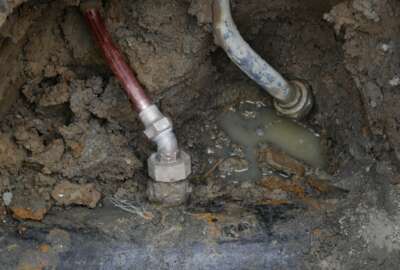GAO checks in on Coast Guard efforts in the Alaskan seas
With the arctic region becoming more of an arena for changing climate, the Coast Guard has stepped up efforts to keep an eye on the Alaskan seas.
With the arctic region becoming more of an arena for geopolitical tensions and a changing climate, the Coast Guard has stepped up efforts to make sure it’s keeping an eye on things in the Alaskan seas. But while the branch may have plans in place, are those plans actually being executed? That was the question a recent report from the Government Accountability Office tried to answer. To learn what they found, the Federal Drive with Tom Temin welcomes Heather MacLeod, Director of Homeland Security and Justice issues at GAO.
Interview transcript:
Heather MacLeod
We were looking really broadly at the Coast Guard’s operations in the Arctic region, which included the way they plan for existing and potentially future risk, as well as how they collaborate with other federal agencies and international partners to manage these risks.Eric White
And so it was all about risk management, it seems. What are some of the bigger risks that the Coast Guard is preparing itself for?Heather MacLeod
As you know, it’s a vast area with harsh weather conditions and an area where we’re seeing increased maritime activity. Some of the risks that they’re examining include a mass rescue event if cruise ships start entering the region, environmental risks, including oil spills, as well as illegal, unreported, unregulated fishing happening in the region.Eric White
It’s only been a few years where the climate has changed so much that there has been so much more maritime activity increased. Is the Coast Guard able to keep up with the amount of activity that has flocked to that arena.Heather MacLeod
Our work found that the Coast Guard faces challenges in this area. The Coast Guard is having difficulty meeting its commitments due to maintenance issues, workforce shortages, limited infrastructure challenges that are pretty well documented happening with the Coast Guard right now, across all of their missions. And it’s exacerbated in this region because of the distance and the challenges of getting up there and forward deploying some of their aircraft or ships.Eric White
This is really the edge of their realm. What are some of the big challenges? You mentioned distance. How does it go about getting cutters up into that region?Heather MacLeod
Well, it takes time. And so they have to balance that with their other missions. The 10, 11 missions that the Coast Guard have are ongoing all the time, and so their ships are are in need of a lot of maintenance. Many of them are past their service life, and new cutters have not come online yet that are planned to be used in the region. So it takes a lot of time and a lot of workforce to make it to the region and keep a force up in the Arctic.Eric White
We’re speaking with Heather MacLeod. She is the director of justice and homeland security issues at the Government Accountability Office. And yes, so you provided me a perfect segue with all of this planning that is needed in implementation plan, and different performance metrics are needed. What did you all find as far as how the Coast Guard is measuring its success in this area, and is it following through on what it has planned for it?Heather MacLeod
Well, we attempted to look at that. That was one of our objectives, and we found that a lot of this information that we were looking for from the Coast Guard was either unavailable or incomplete, and these are specific to their performance reports for recent years. These documents are key for planning in terms of how they’re performing today, as well as what they’re forecasting the needs will be in the future without keeping these records and documenting it in their data systems. It’s really hard for the Coast Guard to anticipate what they need now and what they’re going to need going forward, and how their workforce and the ships and aircraft and assets that they have now are performing in the region.Eric White
Yeah, other than the obviousness of all those things you just laid out. I wonder if you could just expound upon what are the risks when it particularly comes to Arctic coverage that the Coast Guard is putting itself in way of, or in danger of, if it’s not keeping tabs on the nitty gritty stuff of how this vehicle is operating. Where are we in the implementation part of this plan and so forth?Heather MacLeod
Yeah. It’s a risk of not having the information that they need to conduct their missions in the area, especially with increased maritime activity. Other nations are becoming more active in that area. And the Coast Guard is really limited to the the Healy, which is the polar icebreaker. And the Coast Guard has one polar icebreaker while they await the future icebreakers coming online. And so they’re already limited, especially with the increased activity of foreign countries, and just really putting themselves at putting the Nation at risk of not having the information that it needs about what’s even happening in the region.Eric White
And so was there any response from them? You had mentioned that they had staffing issues, as you know, workforce shortages almost every agency is facing them. Was it just a problem of lack of manpower to create this information, or was there just not enough? Was it not technically feasible, just because of how expansive the environment is?Heather MacLeod
It just wasn’t being done, as far as we could tell. So they were keeping some information, but not even what they had outlined the types of information that they need. And so we’re really just asking them to make sure that they’re gathering that information, recording it in their data systems and have it on hand so that they can use it to plan going forward.Eric White
Yeah, let’s get into those recommendations. DHS already concurred with both of the recommendations. What is it that they need to start doing? And just how about are they going to do that?Heather MacLeod
The Coast Guard does have a strategic plan for the Arctic region. They have an implementation plan for their efforts in this area. When we looked at their implementation plan, what we found was really a list of items and actions that they plan to take. What we found missing from that plan are time frames, milestones and how they’re going to measure their performance of those specific actions that they’ve already planned out. And so really it’s additive to what they’ve done. They’ve done some things in this area, and what we found is they could benefit from laying out when and how they’re going to fulfill these actions going forward.Eric White
With their resources being stretched and limited, it drives the importance of coordination even more. Just ask any restaurant manager who doesn’t have enough workers. Not to oversimplify it, but is that the case? They’ll find that you’re almost creating more work for yourself if you’re not doing this from the get go.Heather MacLeod
Absolutely. [Department of Defense (DoD)] is an important player up in the in this area, as well as other nations, including Canadian Armed Forces that the Coast Guard collaborates with a lot in this area. So it’s very important that they have a bigger picture and understanding through these strategic planning documents of who’s doing what and when, and that includes their own plans.Eric White
And finally, let’s just speak to their defense, as you mentioned in the first answer, this is a vast area. Alaska is huge. This is a lot of coastline waters zone of interest, I guess. It’s almost as big as the whole east coast. What kind of undertaking is the Coast Guard tasked with up there?Heather MacLeod
It’s massive and with climate change and the melting of ice, more shipping channels are actually opening, so it’s vast, massive and growing. It’s a real challenge and something that will be increasingly important going forward.
Copyright © 2024 Federal News Network. All rights reserved. This website is not intended for users located within the European Economic Area.
Eric White is news anchor and Federal Drive producer at Federal News Network.
Follow @FEDERALNEWSCAST






